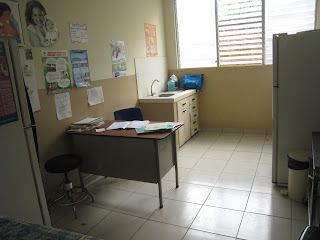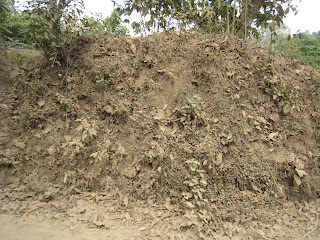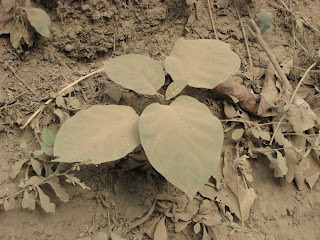We journeyed back to the canton of Virginia today to continue the census. We had to leave early today from the Pastoral House because we needed to make it to a little more than 50 houses before noon. Since we were going so quickly from house to house we didn’t have as much time to chat as we did the day before. I also got to be the translator for one of the groups which meant I was really caught up in asking questions and writing on the census. But I was grateful for the opportunity to practice translating.
By 7:45am we were in Virginia and ready to visit the first house. We followed the same procedure as yesterday and we were in the same groups. And while I can’t write about each family there were several today that stuck out in my mind. I’m going to focus on a few of the families who live in difficult circumstances. Though living in the cantons is a struggle for many families, other circumstances can make life even more difficult.
Family #1
One of the families we visited today was an older couple. There are both in the 70s and even though they live on the same property they actually live in different houses. He lives in one little house and about 40 feet away is another little house where she lives. No one else lives there with them but they have children nearby who are able to help them out. And despite his age, he stills works his milpa (farm) with corn and beans.
Even though they have grown children to help take care of them, I couldn’t help but think about how different it is when people in El Salvador get older. If you live in the cantons, there’s no retirement home here that you go to when you get older. There’s also no retirement. If you can walk, you can work. And if you live in the cantons that means you’ll probably work on a milpa. When you’re an older woman living in the cantons you still have to cook, often using wood for fire and making everything from scratch. You also have to hand wash the clothes for your family. This woman probably still does the bulk of the cooking and washing for herself and her husband.
Isn't she beautiful?!
The couple with one of their sons
who was walking with us
At one of the homes we visited today lived a mom and dad, both 28, with their four children ages 11, 8, 6, and 4 years old. Their youngest son has special needs. He was laying in a hammock when we arrived. Though I don’t know for sure, I think he has mental retardation (now called “intellectual disability”). It goes without saying that having a child with special needs can be difficult. While I don’t have a child with special needs I worked a lot in the past with children who had different intellectual and developmental disabilities.
The little boy at this home isn’t able to walk. He may or may not ever learn to walk. He may or may not be able to get a wheelchair. I’m not sure if he’s able to speak. He didn’t say anything while we were there though we weren’t there that long. He probably needs help getting dressed, using the bathroom, and bathing himself. If you’re even visited the cantons you know that bathing means a bucket shower and using the bathroom means walking outside to the outhouse. Additionally, supportive services and special education don’t really exist here in Berlín, and that’s assuming the family could even get to the city for those services. Thankfully, this boy’s family seemed to be very loving toward him. Like in the US, this may not always be the case.
He was laughing hysterically in the hammock
Mom with her four children
Dad was working in the fields
In one of the very first houses we visited were a man and woman and several children. He is 29 and she is 24. They have four children, ages 7, 4, 2, and 4 months old. I got to the house first because I took a bit of a shortcut. The first thing I saw when I walked in was a baby in the hammock crying and crying. The mom was sweeping the floor; it may be a dirt floor but people still like to keep a tidy home. I introduced myself and she invited me inside. It was a small house that had been divided with black plastic to create a little bedroom in one area.
When everyone else got there someone told us that her husband had cancer. He wasn’t able to get out of bed to greet us because he was so weak but his wife said we could say hi to him. So Kathy, Michelle, and Mitch went back to meet him while I asked his wife the questions on the census. Then Michelle and Mitch presented her with the hammock they’d brought. It will be a help to the family since the one hanging inside the main part of their home looks pretty worn.
Then I went back to say hello to her husband. He was laying sideways on the bed in a tangle of bedding. The bed was made out of petates, a kind of reed, which is what he was laying on. There was no mattress. He was skin and bones and looked like he was in a lot of pain. Blanca gave him a small bag of acetaminophen to help a little with the pain. I told him who I was and that I would be praying for him and his family. He smiled and thanked us for visiting him.
As we walked to the next house and throughout the day we thought and talked about what it would be like to have cancer and live in the cantons. Now, it’s certainly not easy to have cancer regardless of where you live. But the conditions you live in can make a big difference.
To begin, people in the cantons don’t often visit a doctor when they have pain. Pain is a part of life. People also don’t get regular checkups so they wouldn’t be screened for any type of cancer (e.g. mammograms for women). Thus, many times when people get diagnosed with cancer, it is already too far along for any kind of treatment to be helpful. Of course, most people who live in the cantons probably aren’t going to have access to or money for treatments such as chemotherapy or radiation. So even if they catch the cancer in time, you might still die from it.
Along these same lines, you may not be able to get medication to control the pain you’re in. Maybe you’ll get some acetaminophen or ibuprofen from a pharmacy or health promoter visiting the community. But anyone who’s ever watched a loved one die from cancer knows that over-the-counter meds are not sufficient to ease their pain. If you’re really lucky you can get some morphine shots. But again, you need money for that.
So now you’re in pain and dying of cancer. How can it get any worse? Well, there’s no air-conditioning when it’s swelteringly hot and you’re inside your home, which is like an oven because it’s made out of metal. And there’s no heat to keep you warm when it’s pouring down rain and the roof leaks. You’re weak and can do nothing but lay in your bed made of reeds. If you can’t eat solids that means you’ll need to eat liquefied, or close to liquefied, foods. In the cantons that means liquefied beans, corn, rice, maybe some milk, maybe some soup broth.
If you were in this man’s place, you’d also be worrying about your family. As he is dying he will probably be thinking about his family and how they will survive without him. His wife will have to take care of the crops with the help of the 7-year old. If they don’t work their fields they won’t have any food. The kids may or may not be able to go to school. If they are needed in the fields or in the home they might not have the opportunity. While all this is happening there is nothing this man can do for his family but pray.
It is a tragic, terrible way for a person to die.
And it is not an uncommon story.



































